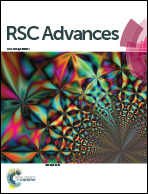Degradation of tri(2-chloroethyl)phosphate by a microwave enhanced heterogeneous Fenton process using iron oxide containing waste†
Abstract
Iron oxide containing waste was first used in the microwave (MW) enhanced heterogeneous Fenton process for removing tri(2-chloroethyl)phosphate (TCEP) in aqueous solution. The operational parameters that affect the removal efficiency were investigated in detail. Comparing with the traditional Fenton-like reaction and heating assisted Fenton-like reaction, the MW enhanced heterogeneous Fenton process displayed superior treatment efficiency. The iron ore tailing can be reused eight times without significant decrease of catalytic efficiency. The major intermediates were identified and the possible degradation pathways of TCEP were proposed. The acute toxicity gradually decreased during the degradation process and the removal of TOC was 98.8% after 35 min reaction. This study could not only apply the waste tailing as a secondary resource to avoid the tedious preparation of the catalyst, but also proposes a rapid, low-cost and effective alternative method for the removal of polluted water containing TCEP.



 Please wait while we load your content...
Please wait while we load your content...